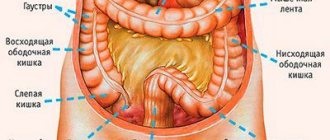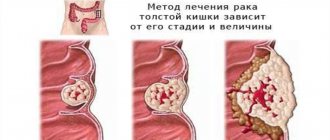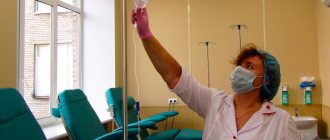The large intestine is the final section of the gastrointestinal tract, extending from 1.5 to 2 meters. In medicine, it is usually divided into separate segments: ascending and transverse colons, cecum with appendix, sigmoid colon, descending colon, rectum.
Colon cancer is a pathological condition in which a malignant tumor develops on the mucous membrane of the intestinal walls. It consists of degenerated cells and has a tendency to grow rapidly. Most often, the neoplasm is located in the blind, sigmoid or direct sections.
Elderly people are at risk. Unfortunately, according to statistics, the number of cases increases every year, despite the development of medicine and the emergence of new methods of treating colon cancer at stages 3 and 4.
What Causes Colon Cancer
If there are relatives in different generations with colorectal cancer in the family, they speak of a hereditary predisposition to colorectal cancer. But poor nutrition and the presence of chronic diseases of the final sections of the intestine, even without a family history, can cause the appearance of a malignant tumor.
A diet poor in fiber, but with an excess of red meat, animal fats, fried, starchy and sweet foods leads to the accumulation of fatty acids in the intestines, which turn into carcinogens. A sedentary and sedentary lifestyle, in turn, contributes to stagnation of blood in the veins of the pelvis and leads to dysfunction of the rectal mucosa. Chronic inflammatory processes occur in the large intestine, causing cell mutations.
Literature
- Solopova A.G., Tabakman Yu.Yu., Vorobyov A.V. Prospects and realities of rehabilitation of cancer patients [Electronic resource] // Journal of Obstetrics, Gynecology and Reproduction, 2015.
- Khasanov R.Sh., Ozol S.A., Gilyazutdinov I.A. Modern principles of rehabilitation of cancer patients [Electronic resource] // Volga Oncology Bulletin, 2013.
- Shmerkevich A.B., Vodolagin A.V., Balakina D.D. Interdisciplinary aspects of rehabilitation of cancer patients in a non-terminal situation of illness [Electronic resource] // Saratov Medical Scientific Journal, No. 13, 2022.
What is colorectal cancer?
Rectal cancer is a malignant neoplasm that develops in the mucous membrane of the final segment of the colon, ending at the anus. The tumor develops, expands its borders on the mucous membrane and eventually goes beyond its limits.
Secondary pathological foci (metastases) appear, which primarily affect the lymph nodes and pelvic organs, and gradually spread throughout the body. A cancerous tumor in the rectum can also develop against the background of precancerous diseases: polyps, fissures, fistulas, proctitis.
Even a slight but prolonged deviation from the usual state of the intestines should alert a person and become a reason to consult a doctor. It’s better to say to yourself: “I’m afraid that I have colorectal cancer” than to blithely dismiss the problem and hear this diagnosis at stage 3-4 of the disease.
Staging
The stages of cancer are indicated by letters (A, B, C) and numbers (0-5). The larger the number and the further the letter in the alphabet, the more severe the disease. Some experts use 1 to 4 markings when comparing cancer with healthy tissue under the microscope.
Let's look at the stages of colon cancer in a little more detail:
- Stage 0 (carcinoma). The wound has not spread beyond the inner layer (mucosa) of the colon or rectum.
- Stage 1. The cancer has spread deeper through the surface (mucosa) of the colon or rectum, but has not gone beyond the walls (localized).
- Stage 2: The cancer has penetrated the walls of the colon or rectum. It did not travel to other parts of the body or lymph nodes.
- Stage 3: The cancer has spread to the lymph nodes, part of the lymphatic system that removes toxins from the body and prevents disease. However, it is absent in other organs and areas of the body.
- Stage 4: The cancer has spread to other organs and is difficult to treat.
Stages
How does colorectal cancer begin?
The first signs of rectal cancer are manifested by abnormal bowel movements in the form of constipation or diarrhea, discomfort, a feeling of heaviness, and a state of weakness. As the size of the tumor increases, minor bleeding appears, which is often mistaken by the patient for hemorrhoids, and he attributes the resulting pain to worsened problems with the liver and gall bladder.
Constant discomfort, pain, false frequent urge to defecate force him to first visit a gastroenterologist or proctologist, and if the doctor suspects cancer, the patient is redirected to an oncologist. The patient most often sees an oncologist-coloproctologist 3-5 months after the onset of the disease.
Advantages of rehabilitation at SM-Clinic
In addition to physical rehabilitation, SM-Clinic specialists pay great attention to psychological recovery. Doctors are developing a complex of therapeutic measures with tonics, immunomodulators and other medications. If necessary, hormone replacement therapy, enzyme therapy and other rehabilitation options are carried out.
All activities are carried out in a comfortable hospital setting, with transfer to outpatient observation or home treatment under the supervision of a doctor. The clinic provides rehabilitation to patients treated in both private and public clinics.
How is colorectal cancer determined?
Modern oncology has high-tech equipment and makes it possible to detect the disease at any stage of development:
- digital examination makes it possible to assess the condition of almost half the length of the rectum and detect a tumor in 90% of patients with oncology of the lower sections;
- if hidden blood is detected in stool and urine tests, further histological and cytological examination, ultrasound, MRI, and biopsy are prescribed;
- An analysis is carried out for tumor markers, general, clinical and biochemical blood tests.
Tumor markers are proteins that are produced by malignant tumors during their life. Their highest concentration is in the blood; by the increased number of these peculiar marks, it is possible to identify the area of the intestine with oncology.
For this purpose, specific markers are used - CA 242, CEA and nonspecific - AFP.
Rehabilitation of post-oncological conditions
The program includes a comprehensive combination of therapeutic therapy and restorative techniques. Depending on the type of disease, the complexity of its course and the recommendations of the attending physician, health measures can be performed at home or in the clinic.
The fight against post-oncological conditions includes:
- psychological assistance;
- drug treatment;
- physiotherapeutic procedures;
- medical and social recovery.
The help of qualified medical specialists will allow the patient to quickly return to normal life. An individual restorative technique is selected for each patient, taking into account medical indicators and the physiology of the patient’s body.
Stages of rectal cancer
Rectal cancer develops slowly over several years, most often asymptomatic at first, and goes through 4 stages of development:
- Grade 1 – a tumor up to 2 cm in size, nearby tissues become inflamed, but there are no metastases.
- Stage 2 – tumor size up to 5 cm, metastases are either absent or single, pain appears.
- Stage 3 – the tumor is more than 5 cm, has already grown through all layers of the intestinal wall and has given multiple metastases to the adjacent lymph nodes, weakness, weight loss.
- Stage 4 – metastases in the abdominal cavity, liver, lungs, spine, brain, the tumor itself begins to disintegrate.
Is it possible to do without surgery for rectal cancer?
Rectal cancer can only be cured by surgery; it also cannot be cured with folk remedies. Surgery is the main treatment for colorectal cancer.
Radiation therapy and chemotherapy are used as an adjunct to surgical treatment and are of secondary importance in complex treatment. But the earlier the tumor is diagnosed, and the higher it is located, the simpler the operation, the better the results and the more complete the rehabilitation.
Complex operations involving the removal of the rectum, anal canal and sphincter muscles require the patient to form a permanent colostomy on the anterior abdominal wall. A colostomy bag is attached to it, which must be periodically replaced in the morning or before bed. The stoma and the skin around the opening should be carefully cared for to avoid irritation.
Cancer treatment abroad
With colon cancer, signs and symptoms only appear when the tumor has reached a significant size. Therefore, effective treatment requires modern methods, high-quality equipment, and the latest generation of medications. Foreign medicine is several levels higher than domestic medicine in terms of the quality of services provided, which is what pushes many people to go to Turkey for treatment.
Oncology treatment in Turkey is characterized by a combination of reasonable prices and effectiveness, thanks to the high level of training of doctors, modern methods of examination and treatment, and compliance with international medical standards.
The material was prepared in agreement with medical doctors, MD. Metin Çakmakçi and Professor Şeref Komurcu.
How long do you live after surgery?
The prognosis for life expectancy after removal of a tumor in the rectum will depend on the stage of the oncological lesion, age and the nature of the treatment performed. The disease, detected at stages 1-2 of the lesion, and surgery in the early stages, give the surgeon the opportunity to remove the tumor and the first minor metastases that do not affect vital organs. In these cases, 65-85% of young patients recover completely, and the rest have from 2 to 5 years of full life.
The likelihood of cancer recurrence sharply decreases after 5 years after surgery, so this period is considered critical. If more than 5 lymph nodes are affected or with metastases in neighboring organs, liver and lung tissues, there is very little chance of extending the patient’s life. In these cases, they do not live to see a year.
The postoperative recovery period also plays an important role in patient survival. In a short time, it is necessary to restore the patient’s body after surgery and chemotherapy with the help of nutritional therapy, and to prevent relapses of the disease.
The main components of rehabilitation after cancer treatment
Aggressive methods are used in the treatment of cancer. Many patients tolerate chemotherapy and radiation therapy worse than the disease itself. After discharge, in this case, long-term recovery is required, both physical and psychological.
Depending on the recovery period, there are:
- early period;
- stationary exposure phase;
- postoperative period;
- recovery phase – prevention of relapse.
An integrated approach is aimed at normalizing or compensating for impaired body functions, preventing disability, resocialization and optimizing the quality of life. Weak psychological security and insufficient support have an adverse effect on the prognosis of the disease.
In modern palliative care, tasks focused on solving problems of psychological and social support and providing social support for cancer patients are relevant. It is about satisfying specific social needs for information, protection, intimacy and practical assistance. The patient must be satisfied with the quality, regularity and frequency of the support he receives.
Recovery after chemotherapy
Recovery from chemotherapy is the primary goal of recovery programs. Drugs prescribed for cancer weaken the immune system and the human body as a whole. Fighting infections becomes more difficult, so it is recommended to begin restorative therapy immediately.
The main methods of improving the patient’s condition after chemotherapy:
- prescribing medications to relieve side effects;
- a balanced diet enriched with vitamins and microelements;
- physical therapy classes;
- physiotherapeutic procedures;
- working with a psychologist.
Due to the fact that chemotherapy is carried out using drugs that affect all rapidly dividing cells, hair loss is observed after treatment. Early measures include the use of special cooling helmets. This approach helps prevent the development of diffuse alopecia.
To restore the level of red blood cells, leukocytes and hemoglobin in the blood after taking chemotherapy, drugs are prescribed that normalize these indicators. Measures are also being taken to restore the intestinal mucosa using a special diet and medications to prevent or eliminate “chemical” duodenitis and gastritis. Medicines reduce the sensitivity of the vomiting center and also help fight lack of appetite.
Restoring physical fitness
To return to work and normal life after cancer, there is a need to restore the body. Physical activity should be started early, starting with simple exercises. As recovery progresses, the load should be increased in accordance with the patient's age and capabilities.
Physical activity helps cancer patients recover faster:
- launching all processes in the body;
- forcing systems and organs to work more powerfully;
- accelerating tissue regeneration.
Regular exercises contribute to the restoration of the body, normalizing lymph exchange, relieving swelling and eliminating the development of any congestion. But too much stress can cause harm. Therefore, classes are conducted under the supervision of a physical therapy trainer.
Among the effective areas, occupational therapy should be highlighted. We are talking about a special technique that is aimed at restoring motor skills lost due to illness. Classes are aimed at developing an algorithm of movements that are necessary to perform everyday tasks.
Psychological rehabilitation
If chemotherapy and radiation are necessary, the participation and moral support of loved ones, as well as the delicacy and tact of familiar people, is very important. Cancer patients are very vulnerable psychologically. They are susceptible to depression, stress, and excessive worries, which do not contribute to a positive treatment outcome.
Psychological rehabilitation of cancer patients plays an important role in the process of recovery of the body. After a terrible diagnosis is made, many people lose interest in their favorite activities and work. Patients after surgery to remove organs and after chemotherapy are especially vulnerable due to the development of adverse reactions and undesirable consequences.
If psychological problems arise, it makes sense to consult a specialist or undergo medical rehabilitation. Such patients should constantly be in the field of view of highly qualified psychologists and receive support from family and friends.
How to prevent colon cancer
A good prevention of rectal cancer is proper nutrition: eating foods rich in fiber, vegetables and fruits, cereals, nuts, which help effectively cleanse the intestines, and up to 2 liters of clean drinking water per day. In addition, you should adhere to the following rules:
- It is necessary to promptly treat precancerous diseases that cause inflammation of the colon - Crohn's disease.
- avoid constipation, exclude fast foods from your diet;
- do not come into contact with harmful chemicals;
- if there is a family history, it is necessary to conduct periodic examinations for tumors in the rectum.
Causes of colon cancer:
- genetic predisposition (close relatives had a similar pathology);
- frequent constipation that occurs due to improper diet;
- long-term course of Crohn's disease or ulcerative colitis;
- familial adenomatous polyposis;
- exposure to bad habits, especially smoking;
- irradiation of the body with ionizing rays;
- eating excessive amounts of fish with small bones, fried and spicy foods, foods with emulsifiers, spices, preservatives that cause constipation and inflammation;
- products that contain carcinogens (indole, skatole) can provoke metaplasia with prolonged exposure to the body.









